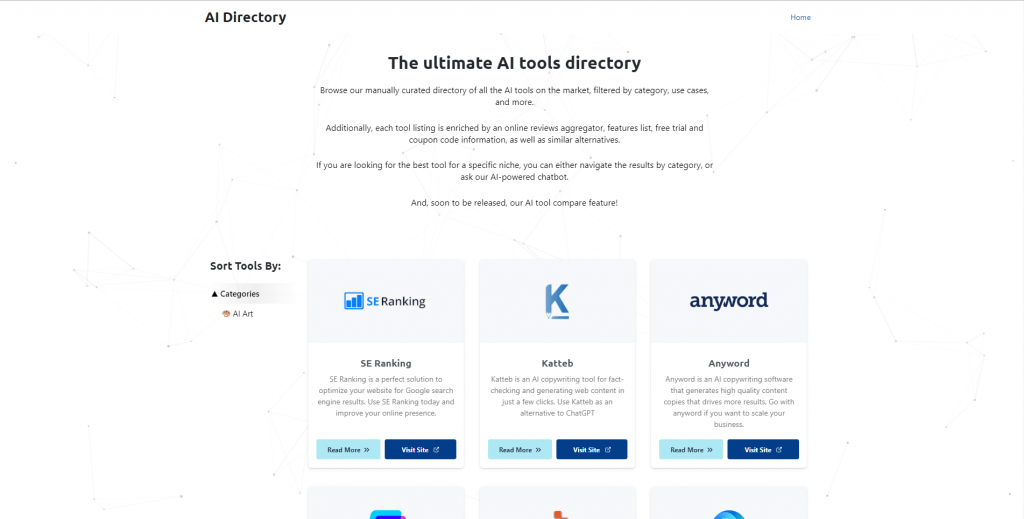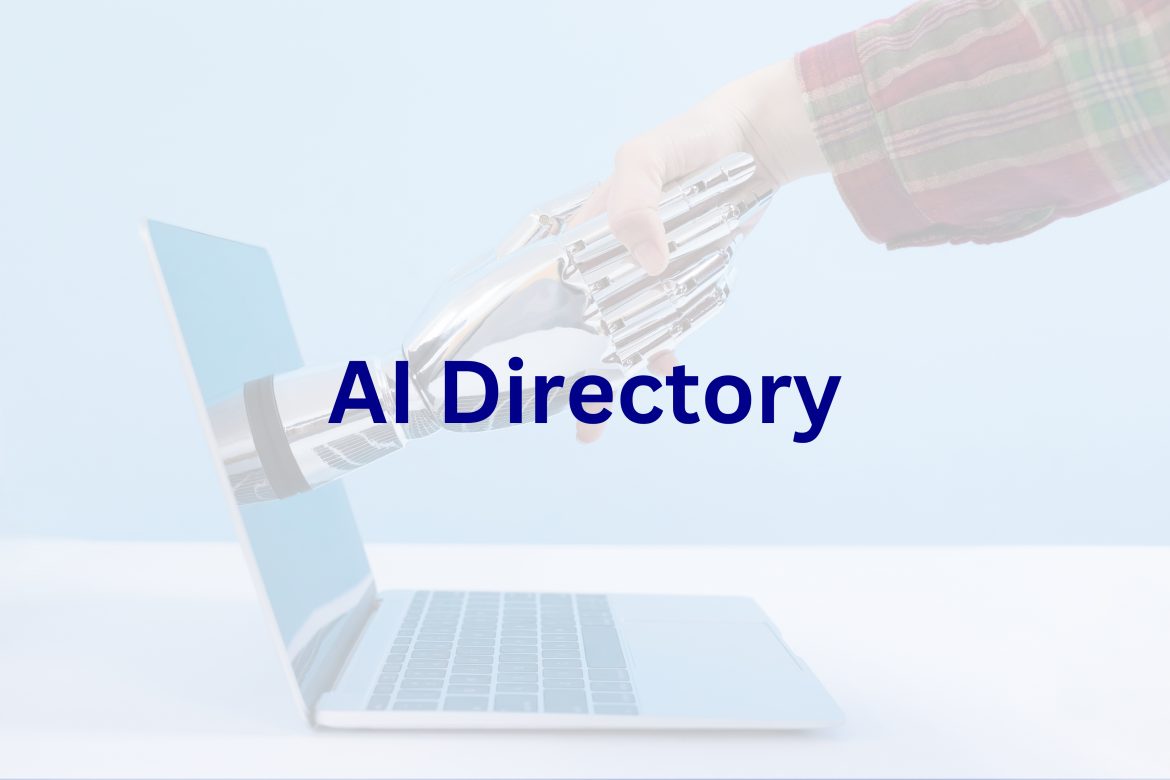AI (artificial intelligence) has become an important part of many businesses because it helps them come up with new ideas and work more efficiently. But there are so many AI options out there that it can be hard to pick the right one for your business. What steps should you take to find the right AI option for your needs in the aforementioned directory?
The development of AI has changed many fields around the world. Businesses in every field, from healthcare to banking, are using AI to make their processes more efficient, make decisions based on data, and improve the customer experience. But it can be hard to pick the right AI product because there are so many on the market.
It’s important to know the different kinds of AI options that are out there and how they can help your business if you want to incorporate AI properly. To find your way around the AI list, you need to think carefully and plan ahead. This piece will walk you through the process and give you useful information on how to find the best AI option for your business.
Identifying Your AI Needs
The field of artificial intelligence (AI) has grown incredibly popular and is now an important part of many businesses. But before companies use AI tools, they need to be very clear about what they need from AI. As part of this process, the company’s goals, problems, and resources must be carefully looked at. Businesses can use AI tools to ease processes, make better decisions, improve the customer experience, and reach their strategic goals if they know what AI they need.
Assessing Business Challenges
When small businesses try to use AI solutions, they run into a lot of problems. Setting up AI to work with certain processes is a big problem. Customized AI solutions are needed for each business because their methods, frameworks, and data are all different. For small businesses with few resources, finding the right setup can take a lot of time and cost a lot of money.
Putting together jobs that are done by people and machines is another problem. AI can handle some jobs, but most of the time it needs help from a person. Making it easy for people and tools to work together can be hard because jobs, tasks, and organizational processes need to be rethought. Employees who are afraid of losing their jobs may be against this integration.
There are also risks that come with using more complex and unified AI apps. Concerns about privacy, bias in decision-making algorithms, and the possible effects of depending too heavily on machine-driven choices are all ethical issues that businesses need to think about. These risks can hurt the trust of customers, the image of the brand, and even have legal consequences.
Determining Business Goals and Objectives
There is a methodical way to set business goals and targets for an AI project that focuses on making sure the project fits in with the organization’s strategic goals. To start, it’s important to look at and understand what the company needs. This means looking at how things are done now, finding problems, and being clear on what you want to happen.
Next, business goals and targets must be made clear and attainable. Along with setting a plan for the AI project, these goals should also be in line with the organization’s general strategic path. Setting clear goals at key points in the project’s timeline is necessary to keep track of progress and make sure goals are being met. Milestones are marks that show when certain jobs or projects are finished. They also help keep track of the project’s progress and schedule.
Also, figuring out what the business needs is important because it helps find places where AI can be useful. Figuring out what the organization’s specific problems and chances are helps people come up with goals and plans that meet these needs. If you know what your business needs, you can use AI to make things more efficient, help you make better decisions, improve the customer experience, or open up new income streams.
Understanding Your Industry
The current state of the business is affected by many things, such as market changes, competition, and new technologies. Trends in the market are very important to the business because they show what customers want and need. Businesses can use these trends to make goods and services that meet customers’ changed wants.
Another important part of the industry scene is competition. As businesses compete for a bigger part of the market, it makes them come up with new ideas and make better goods. To stay competitive, businesses need to know what their rivals are doing and change their plans to match.
Many businesses have had to change because of new technologies. In today’s world, technology is a big part of making things more efficient and productive. From technology to AI, these improvements have made it easier for businesses to run more efficiently and give people better goods or services.
Big players, the rate of growth, and the size of the business all make it unique. The industry can be as small as a niche market or as big as a global business. The growth rate shows how much room there is for growth and wealth. Companies that have a big part of the market and have a say in how the business grows are called “major players.”
In general, for companies to stay ahead, they need to know about the competitors, market trends, industry environment, and new technologies. Companies can deal with the constantly changing aspects of their industry and achieve growth and success by constantly adapting and coming up with new ideas.
Finding the Right AI Solution
Businesses need to find the right AI option in order to improve their processes, become more efficient, and open up new possibilities. There are a lot of different AI technologies and solutions out there today, and businesses have to sort through them all to find the best one for their needs. This means learning about the different kinds of AI solutions, judging their performance and skills, thinking about how they can work with current systems, and judging how long they will last. Artificial intelligence can help companies drive innovation, gain a competitive edge, and reach their strategic goals as long as they find the right AI solution.
Researching Vendors and Solutions Available
There are many sellers and choices on the market for AI tools that aren’t too expensive. These can help marketers who are looking for cheap options. Google’s Google Cloud AutoML AI tool is one of these providers. It has an easy-to-use interface that lets anyone build and launch unique machine learning models without needing to know a lot about code. Marketers should use Google Cloud AutoML because it lets them use AI for cheap jobs like mood analysis, picture recognition, and language translation.
With its Watson AI tool, IBM is another company that sells AI. Watson has many AI features, such as natural language processing and speech recognition, that can help marketing with things like creating content and helping customers. IBM Watson has various pricing plans that make it a good choice for businesses of all kinds that want to save money.
With Azure Cognitive Services, Microsoft is also a big name in the market for low-cost AI tools. Azure has AI models and APIs that are already made, which marketers can use to add to their own apps. These services let marketers improve their efforts without spending a lot of money. They offer features like text analytics, picture recognition, and speech-to-text conversion.
Finally, Amazon Web Services (AWS) has a tool for AI called Amazon SageMaker. It gives you many tools and services to create, train, and use machine learning models. SageMaker is useful for marketers because it lets them improve product ideas, adjust customer experiences, and make their advertising efforts more effective, all without spending a lot of money.
Comparing the Range of Features and Capabilities Provided by Different Solutions
There are many AI-based product and service options that come with a lot of different features and functions to meet the needs of different businesses and users. One well-known use of AI is in self-driving cars, which have features like improved mapping, accident prevention systems, and the ability to drive themselves. These cars use AI systems to understand and read their surroundings. This lets them do things like find lanes, identify objects, and make decisions. Self-driving cars can also have features like adaptive speed control, automatic parking, and maintenance that is planned ahead of time.
Automation as a Service (AIaaS) is another option. This service lets businesses use AI features without having to create their own AI models. Natural language processing, emotion analysis, picture recognition, speech recognition, and suggestion systems are some of the features that AIaaS platforms offer. Businesses can improve the customer experience, simplify tasks, and learn from unorganized data with these features.
When it comes to smart products, integrating AI adds a lot of features and functions that make the user experience better. AI can be used in smart products like freezers, washing machines, and timers to learn what users like, do chores automatically, and use the least amount of energy possible. Smart products that are driven by AI can have features like a remote control, settings that change based on the user, forecast maintenance, and personalized suggestions.
In general, the features and functions that various AI solutions offer are very broad and varied. These include self-driving cars, AIaaS tools for businesses, and AI integration in smart products. These improvements not only make automation and optimization possible, but they also make many areas safer, more efficient, and easier to use.
Investigating the Level of Technical Support Offered by Vendors
A big part of how well companies use AI tools is how well their vendors do their jobs. But the amount of professional help they offer can be very different, especially since different businesses and countries have to deal with different legal loads and compliance hurdles.
In fields with strict rules, like finance and healthcare, sellers must make sure that their AI tools follow the rules and laws that apply to those fields. This includes following rules about data protection, like the General Data Protection Regulation (GDPR) in the EU. To help businesses deal with these regulatory issues, vendors should provide strong technical support, giving advice on how to stay compliant and making sure that their AI tools meet all legal and moral requirements.
The costs that might come with using AI tools are another thing to think about. Companies that want to use AI should include building costs in their budgets, like gear and software updates, so that AI systems can work well. Getting data is also important for teaching AI models, and companies may need to set aside money to get the right datasets. Lastly, topic experts or subject matter experts (SMEs) must annotate data in order for AI models to be more accurate and work better. This can be an ongoing cost for businesses.
To successfully use AI best practices, businesses must carefully think about the amount of technical support suppliers offer to help them deal with legal and safety issues. It is also important to include costs in the budget for infrastructure, data collection, and crowd/SME labeling to make sure that AI tools are used smoothly.
Considering Cost vs. Benefits When Evaluating Vendors
It is important to weigh the costs and benefits of providers and look at the total value they offer when reviewing them. Businesses can then make an informed choice while also making sure they get the most out of their investment.
The cost-benefit study is important because it helps you figure out how much a seller is really worth. Although price is an important factor, judging sellers based only on their prices may have negative effects on your budget. For instance, picking a seller based only on their lower price could mean getting poor quality or service. In the long run, this could cost you more because of things like extra work or unhappy customers.
Also, it’s important to think about the general value that sellers offer. In this case, things like product quality, customer service, dependability, growth, and new ideas need to be looked at. Even if a vendor’s price is a little higher, their total value may be higher than that of a cheaper option if they offer better quality, better customer service, and new solutions.
To show how picking vendors based only on price can hurt your finances, let’s look at the specific factors stated in the background information. People who work for a company that sells cheap goods but doesn’t have quality control methods may send them bad goods. This could mean that they have to pay more for returns, replacements, or refunds, which hurts their bottom line.
In the same way, if a business picks a provider based only on price and doesn’t check to see how quick or reliable they are, they may have problems with contact or supplies. These problems can cause you to miss out on chances, make customers angry, or even get fined for being late with your delivery, which can cost you a lot of money.
Selecting an AI Solution
With technology changing so quickly these days, using Artificial Intelligence (AI) has changed how companies work and how they make decisions. Because there are so many AI options, it’s important for businesses to carefully pick the one that fits their needs the best. For this process to work, you need to know a lot about the different AI options on the market, including what they can and can’t do and how they might affect the business.
Verifying Security Measures in Place for Data Protection
In today’s digital world, where data hacks and illegal access are common, it’s important to check the security steps in place to protect data. To keep data safe, businesses need to put in place strong security steps and keep checking to see if they’re working.
Compliance is a very important part of checking security steps. Depending on the type of data being treated, organizations should follow the right rules and guidelines, like the General Data Protection Regulation (GDPR) or the Health Insurance Portability and Accountability Act (HIPAA). Verification can be done by checks and reviews done by safety teams inside or outside the company.
When checking security steps, privacy is another thing to think about. Companies should have rules and instructions to keep private and important data safe, making sure they collect, store, and use it in a way that follows privacy laws. Regularly checking and watching these steps can help find any privacy holes and fix them right away.
Data security is in danger because of possible hostile strikes. Penetration tests, vulnerability surveys, and threat modeling tasks should be used by organizations to make sure their security steps are working. These actions help groups find flaws and holes that attackers could use, so they can take the right steps to protect themselves.
A good data control plan is just as important as making sure that security steps are working. It is the job of data governance to gather, organize, analyze, govern, and use data in a safe and controlled way. A clear plan makes sure that data is safe, correct, and only available to allowed people or systems. It gives you a way to figure out who owns the data, who is responsible for what, how to make sure the data is kept safe, and what the quality standards are.
Also, when you’re making AI solutions, you need to know what the legal, privacy, compliance, and security effects of the data you use and the algorithms you create are. Compliance with laws and rules is very important. People’s privacy must be respected, and both the models and the data used must be kept safe. Attackers may try to change AI models or get to private data, so it’s important to protect against these kinds of attacks.
Assessing Ease-of-Use and User Interface Design
Evaluating how easy and well-designed the user interface (UI) is is very important for making cheap AI tools work. Ease-of-use is how simple and natural it is to use an AI tool. UI design, on the other hand, is about how appealing the software interface is to the user both visually and functionally.
When judging how easy something is to use, you should look at things like the learning curve, how friendly it is to use, and how clear the directions are. The AI tool should come with clear, brief notes that make it simple for anyone to understand and use, even if they don’t have a lot of expert knowledge or training. An AI tool that is easy to use makes travel smooth and reduces the chance of mistakes or confusion.
In the same way, a good UI design makes using the AI tool more enjoyable for the user. It should look good, be well-organized, be dynamic, and have features and settings that are easy to get to. An easy-to-use interface design gets rid of unnecessary complications and makes sure that users can complete tasks quickly and correctly.
When making cheap AI tools, it’s important to think about how easy they are to use and how the user interface (UI) looks. A lot of the time, inexpensive tools are made for a wide range of people, even those who aren’t very good with technology. By putting an emphasis on UI design and ease of use, these tools can be made available to people who aren’t tech-savvy, which increases their impact and usefulness. A user interface that is easy to use and looks good can also make people think the AI tool is more valuable and trustworthy, which will increase the number of people who use it.

Conclusion
In conclusion, it can be hard to find your way around the AI Directory. You can easily find the best AI options for your business needs, though, if you know what to look for and have the right tools. The important thing is to know exactly what you need, look into your choices, and compare the features of different rivals. After getting that information, you’ll be able to choose the AI option that will help you reach your goals and give you the most value.




